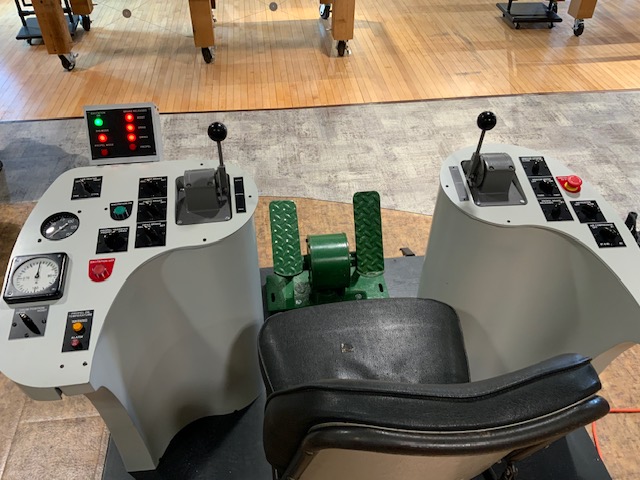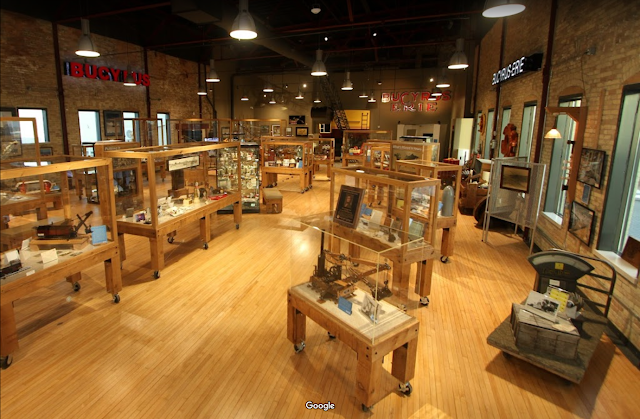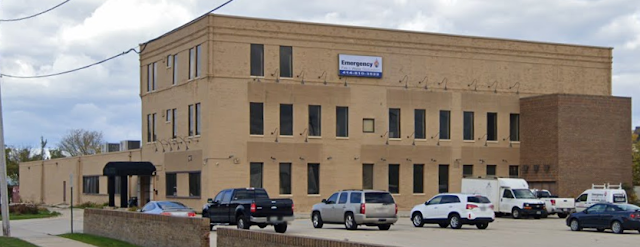(
Satellite)
Bucyrus became part of
Bucyrus-Erie and built large shovels and draglines. The
Bucyrus plant in South Milwaukee is now owned by Caterpillar.
I added the above photo when I saw this street view. I wonder where the museum was located before they moved here. This building was built in 1892. [
BucyrusMuseum]
South Milwaukee Industrial Museum
posted two photos with the comment:
We’re constantly amazed at some of what we find, and the back story that goes with it. We recently acquired this 100+ year old machine builders plate from a Bucyrus 175-B. Many of us at the Bucyrus Museum have never seen or even heard of a 175-B. Then we scoured around to find a photo of one, and see it’s a steam powered shovel with a rack/pinion design handle operating on a platform base. It also came in a dragline configuration. This is a great example of early revolving shovel technology.
Next we’ll get this and the photo mounted in the museum and continue our research. Serial number 1775 is early and our goal is to narrow the manufacture year down to see exactly how old this plate is. Who knows what else we’ll learn along the way. It’s always a journey!
Come visit us! The Bucyrus Museum is open to the public on Tuesdays, Thursdays, and Saturdays from 10 AM until 3 PM. Special group appointments and rates are also available.
 |
| 1 |
 |
| 2 |
South Milwaukee Industrial Museum
posted six images with the comment:
We have now reached 1,020 members! Thank you to everyone who has joined! To celebrate, here we have the Bucyrus-Erie 1020!
The Bucyrus-Erie Type 1020 was a ½ yard convertible machine from the 1930’s. It could be a Shovel, Dragline, Clamshell, Lifting Crane, Drag Shovel or Skimmer Scoop. It could be powered by a gasoline engine, diesel engine or electric motor.
The 1020 was the smallest Bucyrus-Erie built shovel. This blueprint sketch shows a B-E 750-B Shovel standing in the front yard of the South Milwaukee, WI plant. The B-E 1020 Shovel is shown on the dipper of the 750-B. All true scale!
You can see this framed blueprint sketch in person at the Bucyrus Museum which is located at 1919 12th Avenue in South Milwaukee, Wisconsin. We’re open every Tuesday, Thursday, and Saturday from 10am-3pm.
South Milwaukee Industrial Museum
shared |
| 2 |
 |
| 3 |
 |
| 4, cropped |
 |
| 5 |
 |
| 6 |
South Milwaukee Industrial Museum
posted five images with the comment:
We have now reached 1,150 members! Thank you to everyone who has joined! To celebrate, here we have the Bucyrus-Erie 1150-B Walking Dragline!
Bucyrus-Erie launched the 1150-B Walking Dragline in 1944. It was the largest Dragline built at that time. It carried buckets in the range from 20 to 25 cubic yards and weighed approximately 1,200 tons. Its circular tub measured 44 feet in diameter, and the machine was offered with booms from 180 to 215 feet long.
Of the 17 built, 4 were sent to the United Kingdom under the Lend-Lease Act of 1941. One of those, the St Aidan's Walking Dragline is currently preserved near Leeds, England.
The Bucyrus Museum is open Tuesdays, Thursdays, and Saturdays from 10 am to 3 pm. Group events are available outside of normal hours by appointment. Please call to make an appointment.
 |
1
Myron Dudenbostel: Yep. that is Grandma!!! Not real sure of the location, but will say it is north of Blair. Just looking around it....... it looks like it is on the move building road. On closer look... it is in the middle of the paint job. From red and white to orange and yellow. This was before I bid to operators job.... |
 |
2
Bucyrus-Erie 1150-B Walking Dragline stripping overburden and loading in into a hopper.
Terry Brock: it would take a pretty good operator right there to be dumping that in there from sitting that far away and a lot lower,, I have had old timers load me with a smaller drag and couldn,t even hit the bed.
Myron Dudenbostel: Terry Brock Not hard to do with a short dump rope.....
Gibson Smith: Anymore photos of the hopper? |
 |
South Milwaukee Industrial Museum replied to Gibson's comment
Sure do! |
 |
Junior Farmer commented on the above post
1926 Bucyrus Model 160 17 1/2 wrecker still operating at the Illinois Railway Museum . |
 |
South Milwaukee Industrial Museum posted
Here’s a display from the Bucyrus-Erie plant in South Milwaukee, Wisconsin. It was set up for an open house event in 1940. The Bucyrus Armstrong 29-T drill was a design B-E acquired from the December 1932 merger with Armstrong Drill Company of Waterloo, Iowa. As part of the merge, the name ‘Bucyrus Armstrong’ had to be used for 10 years. The other models L to R are a walking dragline, 120B shovel. 95C steam shovel, 15cu/yd Panama Canal dredge ‘Parasio’, and a wooden dipper dredge model. The only one we don’t have a handle on location is the 29-T. We would have loved to see this large scale drill model in person! |
 |
Don Cleason commented on the above post
1928 Bucyrus Erie Class 160 Railway Crane. Getting the boiler reinstalled after being reflued. SP 7020. Should be under steam this summer. |
South Milwaukee Industrial Museum
posted ten images with the comment:
We have now reached 1,260 members! Thank you to everyone who has joined! To celebrate, here we have the Bucyrus-Erie 1260-W Walking Dragline.
The Bucyrus-Erie 1260-W Walking Dragline first appeared in 1965. With buckets ranging from 30 to 42 cubic yards, this dragline sported a computer-designed triangular boom with tubular members. It had three main chord members instead of the usual four. The 1260-W turned out to be one of Bucyrus-Erie’s most popular draglines, with 33 being sold up to 1990.
Come visit us! The Bucyrus Museum is located in the Bucyrus Club, 1919 12th Avenue, South Milwaukee, WI. We’re open Tuesdays, Thursdays, and Saturdays from 10am-3pm.
South Milwaukee Industrial Museum
shared with the comment: "We have now reached 1,260 members! Thank you to everyone who has joined! To celebrate, here we have the Bucyrus-Erie 1260-W Walking Dragline."
 |
| 1 |
 |
| 2 |
 |
| 3 |
 |
| 4 |
 |
| 5 |
 |
| 6 |
 |
| 7 |
 |
| 8 |
 |
| 9 |
 |
| 10 |
South Milwaukee Industrial Museum
posted two mages with the comment:
We have now reached 1,300 members! Thank you to everyone who has joined! To celebrate, here we have the Bucyrus-Erie 1300-W Walking Dragline.
Bucyrus-Erie produced a total of 12 1300-W Walking Draglines between 1971 and 1985. Bucket size ranged from 33 to 47 cubic yards. A few of those named 1300-W Walking Draglines include; Colowyo Coal’s Big Dipper, Drummond Coal’s Donald Duck’s Digger, Luscar’s Nessie, Peter Kiewit’s Rosebud and Arch Coal’s
Walking Stick.
Come visit us! The Bucyrus Museum is located in the Bucyrus Club, 1919 12th Avenue, South Milwaukee, WI. We’re open Tuesdays, Thursdays, and Saturdays from 10am-3pm.
South Milwaukee Industrial Museum
shared |
| 1 |
 |
| 2 |
 |
Nick Stork commented on the above post
Taft 1300 |
South Milwaukee Industrial Museum
posted two mages with the same comment as the above post.
South Milwaukee Industrial Museum
shared |
| 1 |
 |
| 2 |
 |
| 3 |
 |
| 4 |
 |
| 5 |
South Milwaukee Industrial Museum posted two photos with the comment: "We have reached 1,500 members! Thank you to everyone who has joined! To celebrate, here we have the Bucyrus-Erie 1500-W Walking Dragline. Only two 1500-W Walking Draglines were built. Both went to Texas Utilities in 1970 and 1971. They were equipped with 285-foot booms and 70-yard buckets."
 |
| 1 |
 |
| 2 |
South Milwaukee Industrial Museum
posted two photos with the comment:
The Bucyrus Museum was honored when William Oldani (WEO) recently visited with us for two days. WEO is a well-respected mining engineer, and has been an artist for more than 50 years.
We have had a copy of his awesome 4250-W Big Muskie Walking Dragline line drawing, which he produced in 1978, on our art wall since the first day we were open. That same drawing was also selected by the Grohmann Museum back in 2019 to hang in their space as part of their Magnificent Machines of Milwaukee exhibition. That show won the top award in 2019 for historical museum displays from the Wisconsin Historical Society.
During his visit, WEO presented us with two wonderful 3D CAD drawings of four iconic Bucyrus-Erie machines. In one we have American Electric Power's (AEP) Big Muskie (4250-W Walking Dragline) and Amax Coal's 3270-W Walking Dragline. The other shows Peabody Coal's Big Hog (3850-B Stripping Shovel) and Pittsburg & Midway Coal's (P&M) Big Brutus (1850-B Stripping Shovel) in side by side comparisons.
We’ve just had them returned from our professional framer, and will be hanging them in the museum very soon. These are both 1 of 1 prints, signed by the artist, and really ‘pop’ with their vivid colors, precise details, and exact scale of each machine (watch our posts for another WEO 3D CAD drawing item - coming soon!).
South Milwaukee Industrial Museum
shared |
1
Iconic Bucyrus-Erie machines: Amax Coal's 3270-W Walking Dragline and American Electric Power's (AEP) Big Muskie (4250-W Walking Dragline) |
 |
2
Iconic Bucyrus-Erie machines: Peabody Coal's Big Hog (3850-B Stripping Shovel) and Pittsburg & Midway Coal's (P&M) Big Brutus (1850-B Stripping Shovel) |
South Milwaukee Industrial Museum
posted three photos with the comment:
We have reached 1,550 members! Thank you to everyone who has joined! To celebrate, here we have the Bucyrus-Erie 1550-W Walking Dragline.
Two Bucyrus-Erie 1550-W Walking Draglines were built. In 1968 one went to Consolidation Coal in Illinois. The other went to England, where it became the famous Big Geordie operating at Derek Crouch’s Radar North opencast coal site, the largest dragline in Europe at that time. Both 1550-W’s swung 65-yard buckets.
Come visit us! The Bucyrus Museum is located in the Bucyrus Club, 1919 12th Avenue, South Milwaukee, WI. We’re open Tuesdays, Thursdays, and Saturdays from 10am-3pm. Group events are available outside of normal hours by appointment. Please call to make an appointment.
South Milwaukee Industrial Museum
shared with the comment: "We have reached 1,550 members! Thank you to everyone who has joined! To celebrate, here we have the Bucyrus-Erie 1550-W Walking Dragline."
 |
| 1 |
 |
| 2 |
 |
| 3 |
South Milwaukee Industrial Museum
posted seven images with the comment:
We have reached 1,570 members! Thank you to everyone who has joined! To celebrate, here we have the Bucyrus-Erie 1570-W Walking Dragline.
The Bucyrus-Erie 1570-W captured the mid-size walking dragline market with 46 units sold between 1973 and 1991. Boom lengths ranged from 285 to 345 feet, buckets ranged from 58 to 80 cubic yards.
Come see the 1570-W walking dragline sheave and operator seat in person!
 |
| 1 |
 |
| 2 |
 |
| 3 |
 |
| 4 |
 |
| 5 |
 |
| 6 |
 |
| 7 |
 |
Thomas Kagerbauer commented on the above post
I was very lucky to see one 1570-W working last year. |
South Milwaukee Industrial Museum
posted with the comment:
We have reached 1,650 members! Thank you to everyone who has joined! To celebrate, here we have the Bucyrus-Erie 1650-B Stripping Shovel.
Bucyrus-Erie produced the 1650-B Stripping Shovel between 1956 and 1964. The first, operating a 55 cubic yard dipper on a 145-foot boom, was purchased by Peabody Coal Company for its River Queen Mine in Kentucky, where the machine was named after the mine.
Four more were built up to 1964. The others operated with shorter 135-foot booms and dug with dippers up to 70 cubic yards.
South Milwaukee Industrial Museum
shared with the comment: "Bucyrus-Erie 1650-B Stripping Shovel!"
South Milwaukee Industrial Museum
sharedSouth Milwaukee Industrial Museum
shared |
| James Jewitt commented on the above second share |
South Milwaukee Industrial Museum
posted eight images when they reached 1,950 members. See the
Silver Spade notes for the contents of that post.
South Milwaukee Industrial Museum
posted five photos with the comment:
Ever wonder what it was like to sit in a Bucyrus-Erie 4250-W walking dragline, also know as
Big Muskie, operators seat and pull the hoist and drag master switches? Well now you can! It’s the next best thing to the real deal. Thanks to Rick Law for donating the original Big Muskie operators seat and foot pedal swing gear to the museum 4 years ago - it was going to be tossed but was recovered by his dad at AEP when they upgraded the 4250-W’s operators seat.
Our own Dave Austin did a ton of photo and public records research to duplicate the original consoles. He did the drawings for the fabrications and wiring and had the parts fabricated. The finished consoles were assembled using used and NOS 1965 era parts sourced by Ken Tangen and Bob Jelinek. Kevin Kratt donated his time and talent by welding, body working, and painting the consoles for us. Mike McKean made the sturdy pedestal base, and Mike Haws designed and 3D printed the only item we could not find, a working Selsyn gauge.
It all came together when Mike McKean and Dave Austin, along with his son Jonathan, assembled it here in the Bucyrus Museum. The lights, alarms, Selsyn, switches all work. There’s even an era correct cigarette lighter just like the one Big Muskie once had! It’s a hoot to sit down and dream about controlling that massive 220 cubic yard bucket back in the day. We’re so appreciate of everyone who contributed to making this interactive display a reality and a must see (or sit in) spot in our museum. We hope you can visit us and experience this unique display soon!
We’re located at 1919 12th Avenue, South Milwaukee, WI. We're open Tuesdays, Thursdays, and Saturdays from 10 AM until 3 PM.
South Milwaukee Industrial Museum
shared with the comment: "Bucyrus-Erie 4250-W walking dragline, also known as Big Muskie, operators seat and controls are now on display at the Bucyrus Museum!"
 |
| 1 |
 |
| 2 |
 |
| 3 |
 |
| 4 |
 |
| 5 |



































































No comments:
Post a Comment